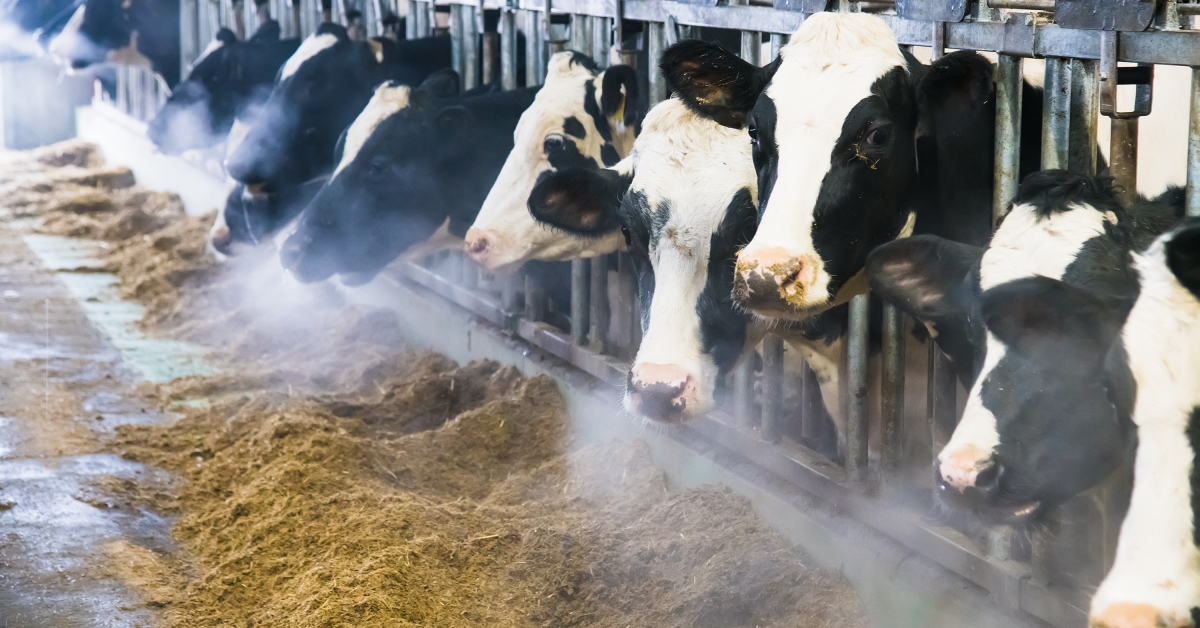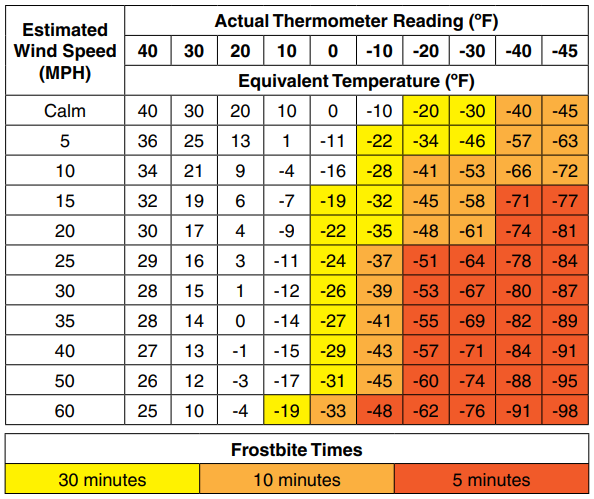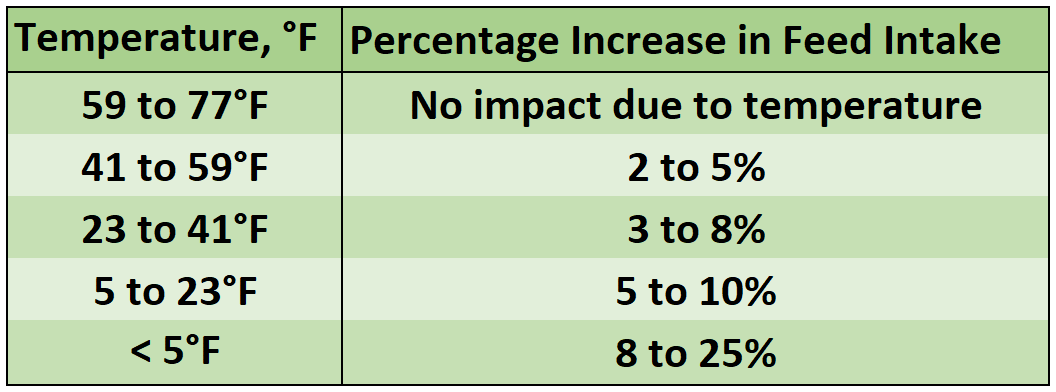
As winter approaches in the United States, there are measures dairy producers can take to prepare for the cold days and nights ahead. Categories to consider as the colder months get closer include housing, management, and nutrition. When temperatures decline, dairy cows divert their energy to maintain normal body temperatures. Focusing on managing the cow’s immediate environment can help to minimize this diversion and aid in optimizing milk production.
Dairy cattle must maintain their core body temperature of around 101 degrees. Cold stress occurs when body temperature drops, and metabolic processes are not enough to keep cattle warm. A cow with a dry winter coat can withstand temperatures of about 18°F, also known as their lower critical temperature (LCT), before feeling cold stress. Energy requirements for an animal with a healthy and dry winter coat increase by one percent for every degree the wind chill temperature falls below the LCT. Energy requirements for an animal with a wet coat increase by two percent for every one degree drop in the wind chill temperature. Frostbite can also be of concern as wind chill temperatures fall below the LCT (Table 1). With shelter from the wind and elements, adequate body condition, a dry coat, fresh water, dry bedding, and good nutrition, dairy cattle can tolerate temperatures well below zero. Factors such as age and breed of cattle along with housing type and environment greatly impact how animals will respond to these weather changes.
Table 1. Wind chill temperatures based on air temperature and wind speed.

Cattle have three priorities that help prepare them for winter: growing hair, adding fat beneath the skin for insulation, and increasing metabolic rate. In traditionally cold areas of the US, where adequate housing is in place, increases in intake can go a long way to help cows maintain core body temperature through increased heat production. A past USDA study highlighted that maintenance energy requirements for lactating cows increase by 50% when the temperature falls from freezing to zero degrees. Additionally, an increase in energy requirements is greater for thin cattle, cows with a wet hair coat, or cattle that have exposure to wind. It is important to note that cows that are housed in tie stall barns will not have the same thick, long haircoats as cows in free-stall barns or cows with access to the outdoors during winter months.
Rations for lactating cows during the winter months should be formulated to meet body maintenance requirements plus milk production, reproduction, and weight maintenance. Energy from feed is first used for body maintenance and we can reduce the need for additional maintenance energy by providing adequate shelter and bedding to keep wind off the animals and the hair coats dry. In colder weather, cows need more calories. Cows commonly increase feed intake as temperature decreases and that increase in intake will typically cover most of the extra energy needed to cover increased maintenance requirements. However, in extreme cold, dry matter intake does not increase at the same rate as metabolism, so animals are in a negative energy balance and shift energy use from productive purposes to heat production, temporarily. In periods of colder temperatures, feed bunks should be monitored more frequently to ensure feed is pushed up and that intake potential is being met with adequate feed delivery. Dry matter intakes may fluctuate greatly in winter months as temperatures drop and necessary increased maintenance energy levels follow. It is not uncommon for cows to require an additional 20% more feed during cold weather (Table 2.) to maintain body condition, maintenance, productivity, and ward off illness.
Table 2. Temperature effects on dry matter intake in cattle.

Water is also a crucial component that is sometimes overlooked. Frozen water or excessively cold water significantly reduces water and feed intake. Cows can drink 3 to 5 gallons of water per minute, so the water supply needs to keep up with demand. Check regularly to ensure that waterers or water tanks are not frozen. Also check the area surrounding the waterer to ensure that it is free from ice. A buildup of ice around the waterer can deter cows from visiting the waterer because of the risk of slipping. Check to make sure that tank heaters are working properly and that the waterer heating elements are also in proper working order. All heating elements should be properly grounded and in good working order to minimize the chance of stray voltage. Cows prefer water between 40 and 65°F. If the water gets much colder than 40 degrees, water intakes and dry matter intakes can both be reduced.
One issue that is not often considered during winter is the impact of cold temperatures on the feed cows are consuming. Wet forages and byproducts can freeze during long stretches of very cold temperatures, resulting in chunks of feed and sorting at the bunk. These higher moisture/frozen rations can become problematic at the feed bunk in times of extreme cold, as frozen feed can lead to reduced intakes. As frozen forages are consumed, cows must work harder to warm up that TMR, which requires additional energy utilization. Additionally, in extreme cold, dry matter digestibility can be lowered due to an increased rate of passage of feed through the digestive tract. Because of the effects of low temperature on digestibility, under extreme cold weather conditions, feed energy values could possibly be lower than expected. Ration modification may be warranted depending on the level of dry matter intake and production parameters. If intakes are limited due to frozen feeds, it results in the need for more energy-dense rations to meet the cow’s requirements for maintenance, growth, and/or lactation. Slight increases in energy inclusion (starch, sugar, and/or fat) during this time can help to moderate energy losses due to lower intakes.
Cattle do have the ability to acclimate to evolving environmental conditions and are relatively less sensitive to cold conditions compared to other domestic animals. This cold hardiness is due to their large size, their usually effective thermal insulation, and the amount of heat produced through normal digestion and metabolism. Cattle that are acclimated to the cold not only have a higher metabolic rate, but also a greater capacity to increase their rate of metabolism to prevent hypothermia during periods of severe cold stress. Because of these processes, cattle that are acclimated may survive cold conditions that would cause death in cattle that had not yet become accustomed to a cold environment.
Concentrating on methods and strategies to keep cows dry and comfortable will help to mitigate challenges during times of freezing temperatures. Providing increased energy and adequate access to water, and protection from environmental conditions during cold weather is crucial to help maintain animal health and cow performance.
- Log in to post comments
